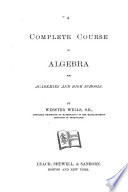 | Education, Higher - 1881 - 504 pages
...multiplied or divided by the same quantity the results are equal. (ii) Any quantity may be transposed from one side of an equation to the other by changing its sign. (iii) If the sign of every term in an equation be changed the equality still holds. (iv) An equation... | |
 | Webster Wells - 1885 - 368 pages
...the same quantity, without destroying the equality. TRANSPOSITION. 172. Any term may be transposed from one side of an equation to the other by changing its sign. For, consider the equation x + a = b. Subtracting a from both members (Art. 171), we have x + a —... | |
 | Webster Wells - Algebra - 1885 - 370 pages
...the same quantity, without destroying the equality. TRANSPOSITION. 172. Any term may be transposed from one side of an equation to the other by changing its sign. For, consider the equation x + a = b. Subtracting a from both members (Art. 171), we have x+a- a=b—... | |
 | Webster Wells - Algebra - 1885 - 324 pages
...the same quantity, without destroying the equality. TRANSPOSITION. 172. Any term may be transposed from one side of an equation to the other by changing its sign. For, consider the equation x + a = b. Subtracting a from both members (Art. 171), we have x + a —... | |
 | Henry William Lovett Hime - Quaternions - 1894 - 240 pages
...= - (+ a). Also, since AC - AB = BC, and ÄC = BC + ÄB; it follows that a vector may be tranferred from one side of an equation to the other by changing its sign. 14°. Since BC + AB =ÄC, 12°, it follows that directions can be assigned to the sides of any triangle,... | |
 | Edwin James Houston, Arthur Edwin Kennelly - Mathematics - 1898 - 120 pages
...= c (5) then a+bb=cb (6) or, a = c — b (7) From this it is evident that we may carry over a term from one side of an equation to the other by changing its sign ; for, in equation (5) the positive quantity b, is on the left-hand side of the equation, whereas in... | |
 | Seymour Eaton - 1899 - 362 pages
...are equal. 4. If equals are divided by equals, the quotients are equal. Any term may be transposed from one side of an equation to the other by changing its sign. Thus : 3 x — 8 = x + 12. Therefore, 3 x — x = 12 + 8, and 2 x = 20, and x = 10. In this example,... | |
 | 1908 - 650 pages
...ж8-1/а-га. 3. Solve the equation : — 4. How would you show that any quantity may be transferred from one side of an equation to the other by changing its sin? 5. Find the value of — /vY + ^54" _ /Vf-^Sy \Vf~-Vb) ' W7 + V5/' 6. Find the square root of... | |
 | Earle Bertram Norris, Kenneth Gardner Smith, Ralph Thurman Craigo - Arithmetic - 1913 - 234 pages
...by changing its sign from — to + . Ifa = Z-7in. then a+7 in. =1. Hence, any term may be transposed from one side of an equation to the other by changing its sign. This may also be explained in another way which is often quite useful. We can imagine that we have... | |
 | Ernest McCullough - Surveying - 1915 - 468 pages
...and the unknown quantities on the other side. Then collect by addition. Any term may be transposed from one side of an equation to the other by changing its sign from + to — , or from — to + . // a term be found on both sides with the same sign it should be... | |
| |